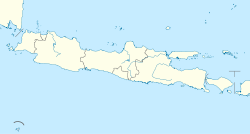Taman Sari (Yogyakarta)
| Taman Sari | |
|---|---|

The bathing complex of Taman Sari.
|
|
|
Location in Java
|
|
| General information | |
| Architectural style | Javanese, Castle |
| Town or city | Jl. Ngasem, Yogyakarta |
| Country | Indonesia |
| Coordinates | 7°48′37″S 110°21′32″E / 7.810151°S 110.358946°E |
| Construction started | 1758 |
| Completed | 1765/9 |
| Client | Hamengkubuwono I |
| Design and construction | |
| Architect | Tumenggung Mangundipura, Demang Tegis (legendary) |
Taman Sari also known as Taman Sari Water Castle is a site of a former royal garden of the Sultanate of Yogyakarta. It is located about 2 km south within the grounds of the Kraton, Yogyakarta, Indonesia. Built in mid 18th century, the Taman Sari had multiple functions, such as a resting area, a workshop, a meditation area, a defense area, and a hiding place.
Taman Sari consisted of four distinct areas: a large artificial lake with islands and pavilions located in the west, a bathing complex in the centre, a complex of pavilions and pools in the south, and a smaller lake in the east. Today only the central bathing complex is well preserved, while the other areas have been largely occupied by the Kampung Taman settlement.
Since 1995 the Yogyakarta Palace Complex including Taman Sari is listed as a tentative World Heritage Site.
The name Taman Sari comes from the Javanese words taman, meaning a "garden" or "park" and sari, which means "beautiful" or "flowers". Hence, the name Taman Sari means an area of a beautiful garden adorned with flowers. An old article described it as a "water castle" (Dutch: waterkasteel); as by shutting the watergates, the complex would be completely immersed in water, leaving tall structures standing out.
The building of Taman Sari commenced during the reign of Sultan Hamengkubuwono I (1755–1792), the first sultan of the Yogyakarta Sultanate, and was completed by the time of Sultan Hamengkubuwono II. The building site, however, had already been known as a bathing place called Pacethokan Spring since Sunan Amangkurat IV’s reign (1719–1726). According to Kitab Mamana in Yogyakarta Kraton, the project leader for the construction of Taman Sari was Tumenggung Mangundipura. He had travelled twice to Batavia to learn about European architecture, which is the reason why the architecture of Taman Sari has marks of European style. The Regent of Madiun, Raden Rangga Prawirasentika, participated in funding the construction of Taman Sari. Prawirasentika also beseeched the Sultan to be relieved of Madiun's tax obligation. He offered other alternative ways of payment. The Sultan accepted his proposal. In 1758, the Sultan commanded the Regent to supervise the making of bricks and various complements, which would be used to build a beautiful garden. The sultan wanted a place where he could spend some time to relax after many years of wars that he had just experienced. Raden Tumenggung Mangundipura, under supervision of Raden Arya Natakusuma (who later became Sri Pakualam II), was responsible for the construction. The building was started in 1684 Javanese year (1758 AD). After finding out how large the complex was, Raden Rangga Prawirasentika realized that the cost would have been greater than the taxes. He resigned from the project and was replaced by Prince Natakusuma who continued the project to completion.
...
Wikipedia

